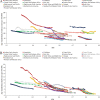The global, regional and national burden of peptic ulcer disease from 1990 to 2019: a population-based study
- PMID: 35144540
- PMCID: PMC8832644
- DOI: 10.1186/s12876-022-02130-2
The global, regional and national burden of peptic ulcer disease from 1990 to 2019: a population-based study
Abstract
Background: Peptic ulcer disease (PUD) is a common digestive disorder, of which the prevalence decreased in the past few decades. However, the decreasing tendency has plateaued in recent years due to changes in risk factors associated with the etiology of PUD, such as non-steroidal anti-inflammatory drug use. In this study, we investigated the epidemiological and the sociodemographic characteristics of PUD in 204 countries and territories from 1990 to 2019 based on data from the Global Burden of Disease, Injuries and Risk Factors (GBD) Study.
Methods: Demographic characteristics and annual prevalence, incidence, mortality, disability-adjusted life years (DALYs) and age-standardized death rate (ASR) data associated with PUD were obtained and analyzed. According to the sociodemographic index (SDI), the numbers of patients, ASRs, estimated annual percentage changes and geographical distributions were assessed with a generalized linear model and presented in world maps. All evaluations of numbers and rates were calculated per 100,000 population with 95% uncertainty intervals (UIs).
Results: In 2019, the global prevalence of PUD was approximately 8.09 [95% UI 6.79-9.58] million, representing a 25.82% increase from 1990. The age-standardized prevalence rate was 99.40 (83.86-117.55) per 100,000 population in 2019, representing a decrease of 143.37 (120.54-170.25) per 100,000 population from 1990. The age-standardized DALY rate in 2019 was decreased by 60.64% [74.40 (68.96-81.95) per 100,000 population] compared to that in 1990. In both sexes, the numbers and ASRs of the prevalence, incidence, deaths and DALYs were higher in males than in females over 29 years. Regionally, South Asia had the highest age-standardized prevalence rate [156.62 (130.58-187.05) per 100,000 population] in 2019. A low age-standardized death rate was found in the high-income super-region. Among nations, Kiribati had the highest age-standardized prevalence rate [330.32 (286.98-379.81) per 100,000 population]. Regarding socioeconomic status, positive associations between the age-standardized prevalence, incidence, death rate, DALYs and SDI were observed globally in 2019.
Conclusions: Morbidity and mortality due to PUD decreased significantly from 1990 to 2019, while a gradual upward inclination has been observed in recent 15 years, which might be associated with changes in risk factors for PUD. Attention and efforts by healthcare administrators and society are needed for PUD prevention and control.
Keywords: Disease burden; Global Burden of Disease; Injuries and Risk Factors Study; Peptic ulcer disease; Sociodemographic characteristics.
© 2022. The Author(s).
Conflict of interest statement
All authors declare that they have no conflicts of interests.
Figures





References
-
- Sverdén E, Agréus L, Dunn J, Lagergren J. Peptic ulcer disease. BMJ (Clinical research ed). 2019;367:l5495. - PubMed
-
- Lanas A, Chan F. Peptic ulcer disease. Lancet (London, England) 2017;390(10094):613–624. - PubMed
-
- Gralnek I, Dumonceau J, Kuipers E, Lanas A, Sanders D, Kurien M, et al. Diagnosis and management of nonvariceal upper gastrointestinal hemorrhage: European Society of Gastrointestinal Endoscopy (ESGE) Guideline. Endoscopy. 2015;47(10):a1–46. - PubMed
-
- Lau J, Sung J, Hill C, Henderson C, Howden C, Metz D. Systematic review of the epidemiology of complicated peptic ulcer disease: incidence, recurrence, risk factors and mortality. Digestion. 2011;84(2):102–113. - PubMed
MeSH terms
LinkOut - more resources
Full Text Sources
Medical
Miscellaneous

